- 1. Produce original content
- 2. Optimize your ecommerce website's layout
- 3. Content marketing
- 4. Social media marketing
- 5. Email marketing
- 6. Search engine optimization (SEO) for ecommerce
- 7. Pay-per-click advertising (PPC for ecommerce)
- 8. Optimize for mobile
- 9. Use social commerce
- 10. Humanize and personalize
- 11. Retargeting
- Next steps to ecommerce success
🎙 On the go? Listen to the article through our podcast, Cave Bits!
Listen to more episodes of Cave Bits
Which ecommerce marketing strategies are worth the time and investment?
Whether your online retail company is just starting up or has reached the point where you have a well-established customer base, it’s important to stay up to date with the most current ecommerce marketing trends and techniques for your business. Either you do it, or somebody else does and steals your customers.
So, it’s crucial to invest in an effective website structure and ecommerce marketing strategy. In this article, we break down both the best tried-and-true methods and the newest techniques of marketing for an ecommerce business.
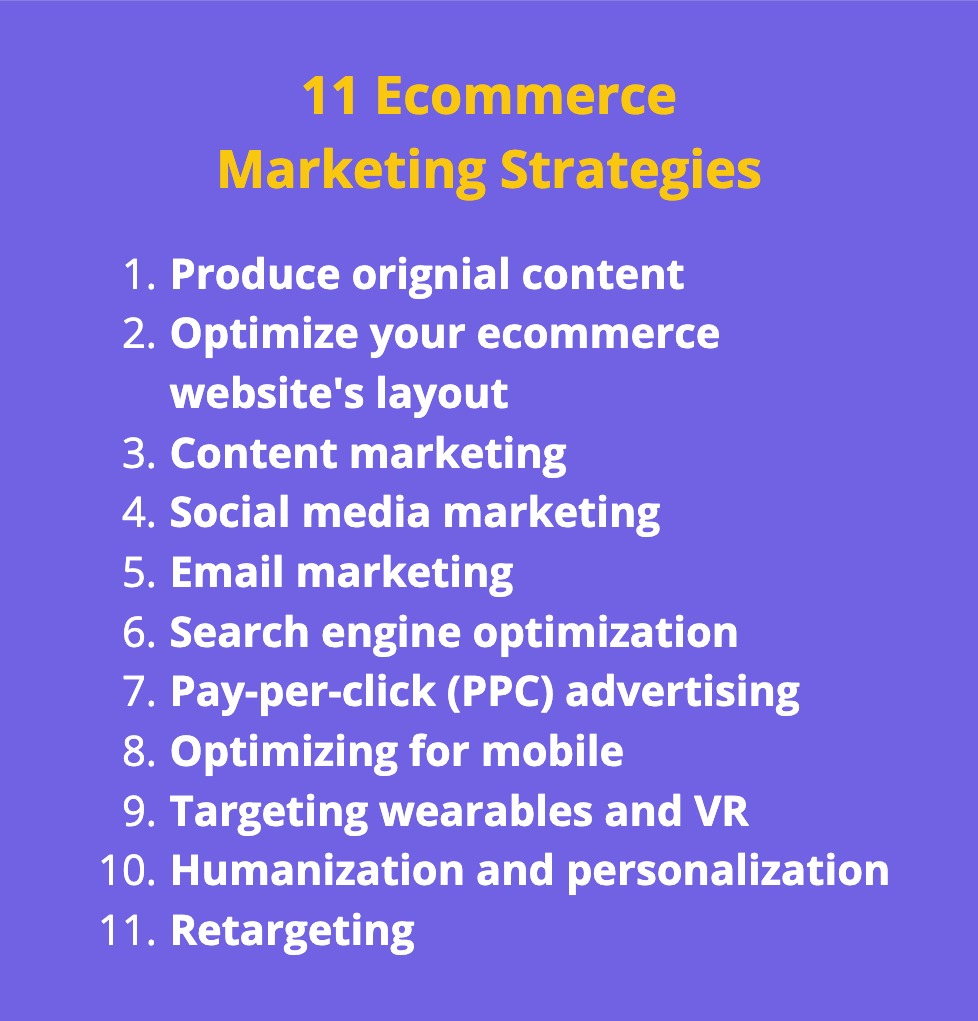
1. Produce original content
The first step in setting up an ecommerce website is creating the content for it. Creating high-quality, original, and engaging content will set you up for success because it will resonate with your customers in a way that makes them want to interact with you, purchase from you, and maintain a following.
Be creative. Be original. Be bold.
Promoting original content is a great way to make a statement, strike a compelling idea, and make a mark on the user’s mind. But there is a fine line between content that engages users and content that deters them.
Why not take an extra step, put in a little effort, and create something that will be genuinely compelling? It’s an ecommerce marketing strategy with lasting effect. One or two well-written pages or ads can drive revenue for years to come.
What should you write?
- Create informative content to your primary site pages – your homepage, about page, policies (warranties, shipping, etc.) at the bare minimum. That’s what helps your website visitors build trust in your business.
- Populate your online store’s product content. Start with individual products, prioritizing by your best sellers or highest earners, and write unique descriptions. Don’t just drop in the manufacturer’s boilerplate language. Explain what it is, why it’s better, and its key features. Keep your audience and the language they speak in mind – you should be speaking the same language on the product pages
- Look also to category pages. These also pose great SEO opportunity (more on that below). Here’s where you can explain a type of product (e.g., men’s athletic shoes) and provide paths to other products, to help the user find what they’re looking for. FAQs are often handy on category pages to answer questions related to the segment (e.g., “how to choose men’s athletic shoes”).
Now, it’s time to get proactive.
- Spawning from your ecommerce company’s authority (e.g., shoes), publish blog posts that will attract new audiences while informing and engaging existing fans. Shoe fashion trends, best shoes for college life, how and why Nike shoes changed over time – again, think what would be interesting for your audience and go for it!
- Add rich content to your website, too – in ecommerce, a product demo or explainer videos are a supreme fit.
If you’re coming up short of ideas, ask your customers. Use a user feedback tool offering pop-up chat interactions to ask, for example…
- What are you looking for?
- What do you want to learn more about?
- What questions do you have?
- What brought you here today?
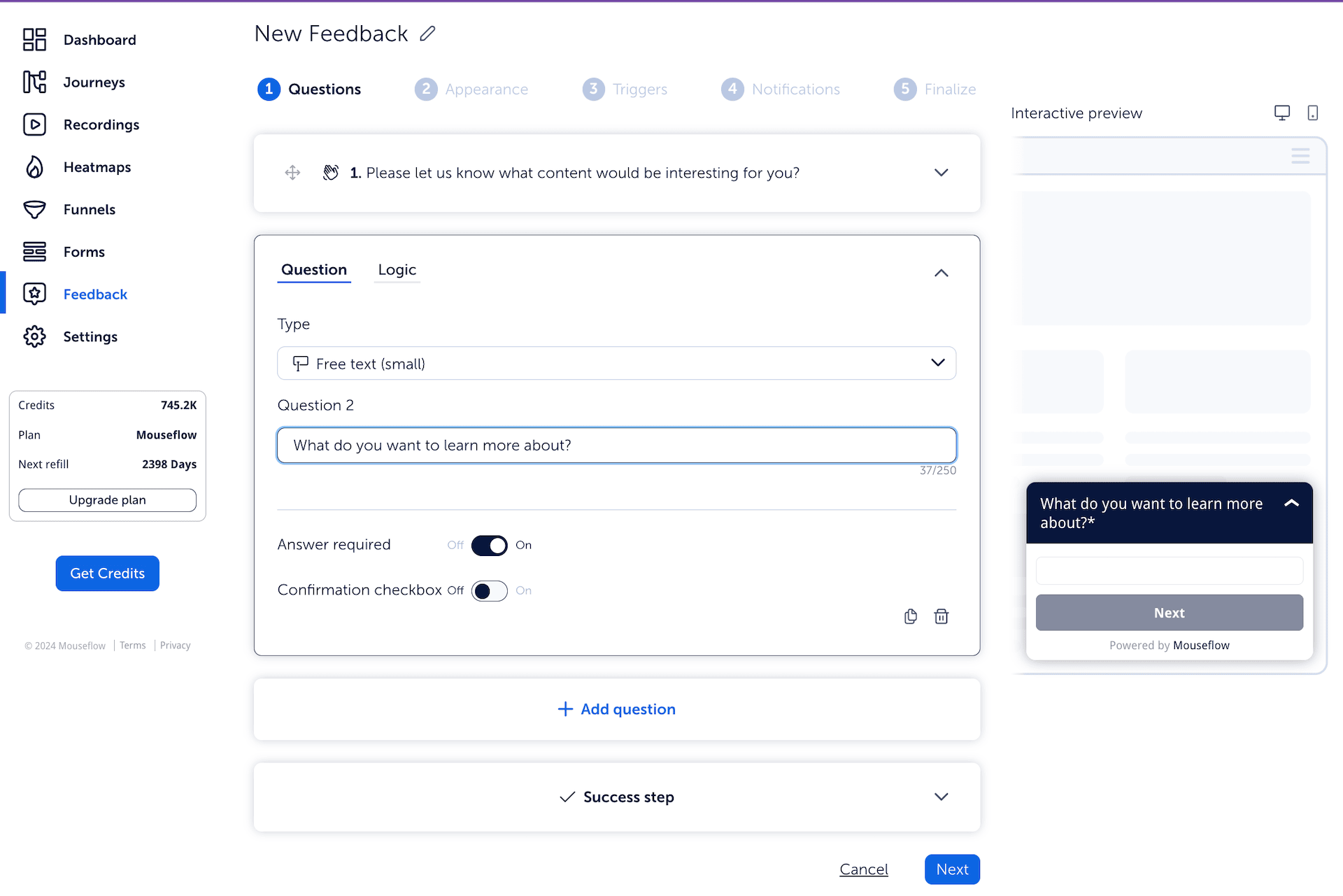
Create surveys to inform your ecommerce content marketing strategy
Your goal is to zero in on content topics that your audience cares about – because they tell you so. More on content beyond core “money pages” below as we talk content marketing.
Example
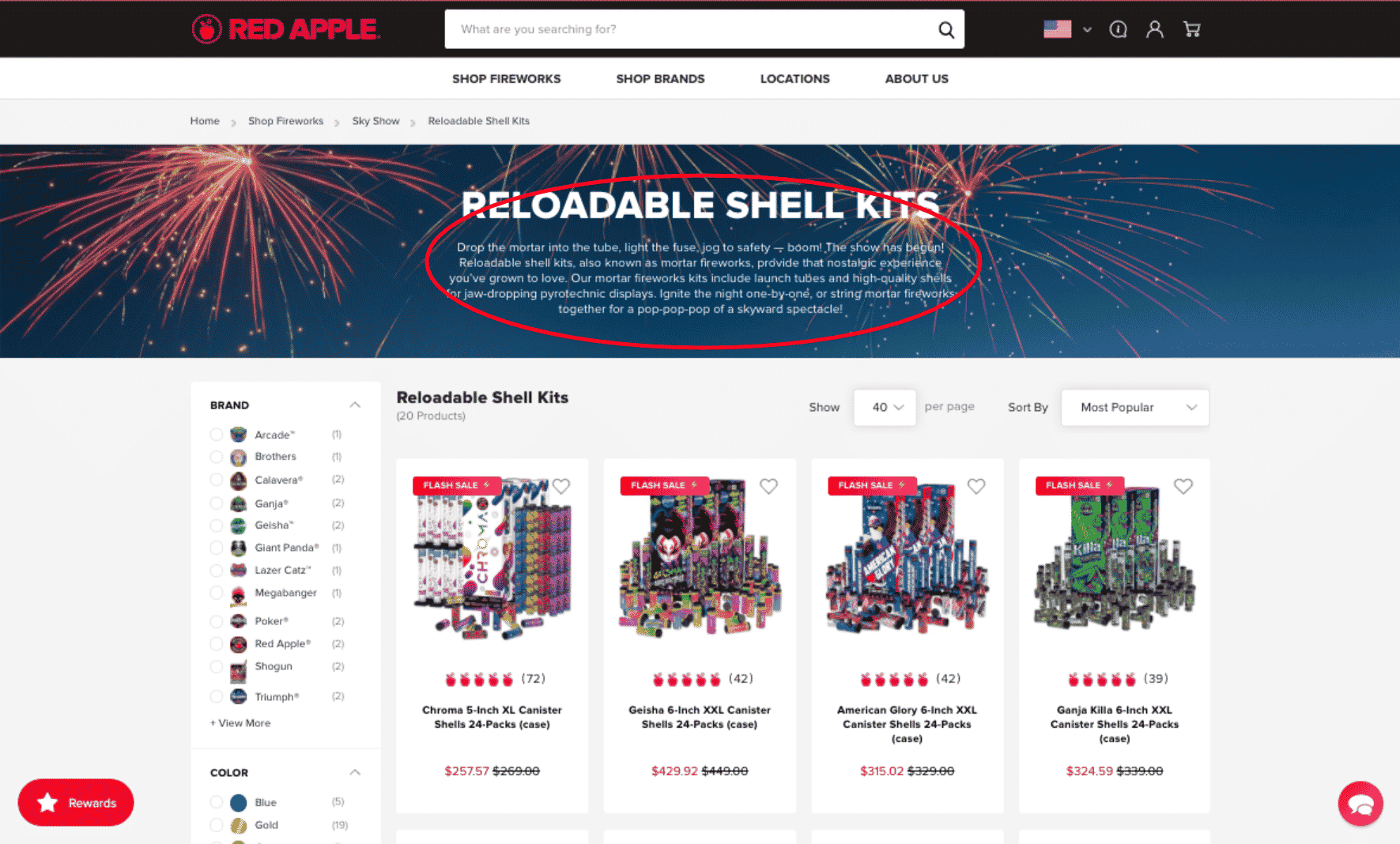
This online fireworks company added informative content to their category pages that answers common questions about specific types. Not only did this drive SEO performance, it increased engagement, conversions, and order value.
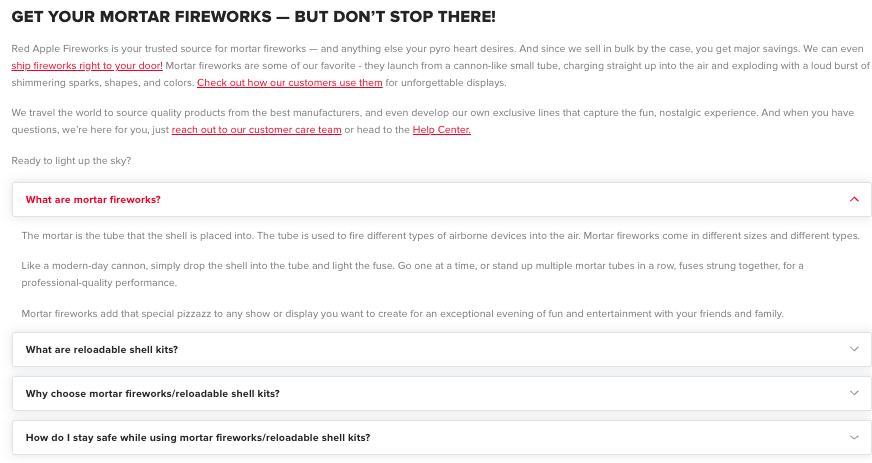
2. Optimize your ecommerce website's layout
After launching or redesigning your ecommerce site, it’s important to test your website’s layout, language, and placement of conversion elements. When customers visit your website, you want to make sure it’s easy and simple to check out, that they feel naturally inclined to purchase your products, and that it’s abundantly clear how to do so.
You should test the language displayed on your landing and product pages, the language in your conversion elements, and even the strategic placement of icons and elements. You can use various usability testing methods for this.
One really nifty tool is Mouseflow’s heatmap software that reveals valuable patterns in customer behavior on your website. One of their most popular heatmaps, the movement heatmap, reveals the most attractive parts of your website — based on visitor movement data to your website.

With a color guide, Mouseflow will tell you where your customers spend the most time, and the least amount of time! If a specific area of your page receives more attention (in white), you should consider moving your conversion elements to those more attractive areas to increase click-through rates (CTR).
You’ll also want to set up a conversion funnel analysis and optimization tool. With this, you can assign pages on your site to a funnel and analyze how users move through the journey.
You’ll find that certain pages and funnel journeys perform better than others. You can also watch session recordings of users that dropped and converted, to better empathize with their experiences.
Test it for a week and see how your conversions change. Take your ecommerce marketing strategy to the next level with an ecommerce conversion rate optimization strategy using these methods.
Mouseflow’s affordable, scalable pricing plans gets you started for free and grow with you as you become an ecommerce power player.
3. Content marketing
Proper ecommerce content marketing can attract more positive attention, interaction, and sustainable conversions in a way no other marketing method can. By creating and promoting original content, you are ensuring that your audience is receiving new information that matters to them on a continual basis.
Content for your website, like mentioned above, includes home page, category pages, product pages, and the like. Content marketing on the other hand is content specifically geared to attract customers and is promoted to get their attention.
Brainstorm with your team to create a list of the different types of content you wish to create. This can be blog posts, videos, and newsletters. Also, make sure you are utilizing your marketing budget by consulting with experts, outsourcing work when necessary. Invest in high-quality software, subscriptions, employees, and training for your team.
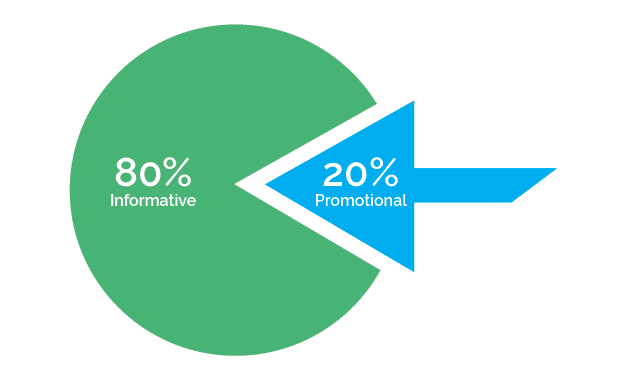
You will also find that if you work with the right people, many of the things you’ve paid for in the past can be done internally. Create diversity within your team and listen to everyone’s ideas.
And in the spirit of listening to everyone’s ideas, deploy a user feedback tool to collect questions, thoughts, and topics from your audience. Or, “listen” to their behavior – use heatmap tools to identify the parts of your website, and even parts of specific pieces of content, that get the most interest. then expand on these topics, and link them within the content’s “hot spot”.
We also suggest that you create content based on Pareto’s 80/20 rule, which means that your promotions should comprise of 80% informational content, and 20% promotional content. All of the content you publish should be relevant, interesting, and unique.
4. Social media marketing
Social media ecommerce marketing is a very powerful tool. It allows you to communicate with your industry, customers, and market in a personal, public way. You can utilize social media to generate engagement and interaction, boost brand awareness and traffic to your website, and develop a larger base of customers. Finally, there’s such things as Instagram shop or Facebook shop that can sell directly on the social media platform, without forcing the user to leave it.
Utilizing different social media platforms for different purposes also creates a rich presence for your company that diversifies your abilities and efforts. This will ultimately help you cater to your customers’ needs in a way that grows your business over time.
Maintaining a solid tone and personality of your company through social media is very important because consistency is what will create trust within your audience. In order to develop and maintain brand recognition and authority, make sure your outreach efforts are unified by ensuring your team is on the same page with your company’s communication style.
One particular interesting eCommerce marketing tactic is incentivizing your audience to create user generated content – ask them to make photos with your products or create short videos to receive some bonuses. Not only that helps bring in new audiences (who follow those participating in the activity), it also may help increase customer loyalty through humanizing your brand.
Just as important as being present and engaged on social is monitoring this channel’s performance. To do so, you’ll want to use your web analytics tool to…
- Monitor the performance of the social referral journey on-site with a funnel optimization tool.
- Review user session recordings to understand why customers abandoned the journey, what compelled them to convert, and what caught their interest along the way.
- Bonus tip: look at the full on-site journeys of your converted customers and consider how to adjust your pre-defined funnel to better meet these needs. You may have forgotten to consider a customer’s affinity for visiting your reviews page, and can identify this as a key conversion-journey touchpoint.
- Analyze the behavior of the distinct social segment via heatmaps. How deep do they scroll? What sections get the most interest? where are they compelled to click? Use this to inform campaign and strategy tweaks.
- Ask the audience for user feedback via pop-up chat tools at key moments in their journey, such as when they stay on a page for long enough or have exit intent.
- Run through your forms with a fine-toothed comb via form analysis tool. You may find that social audiences are more or less inclined to give up information, and can adjust your form fields to suit them.
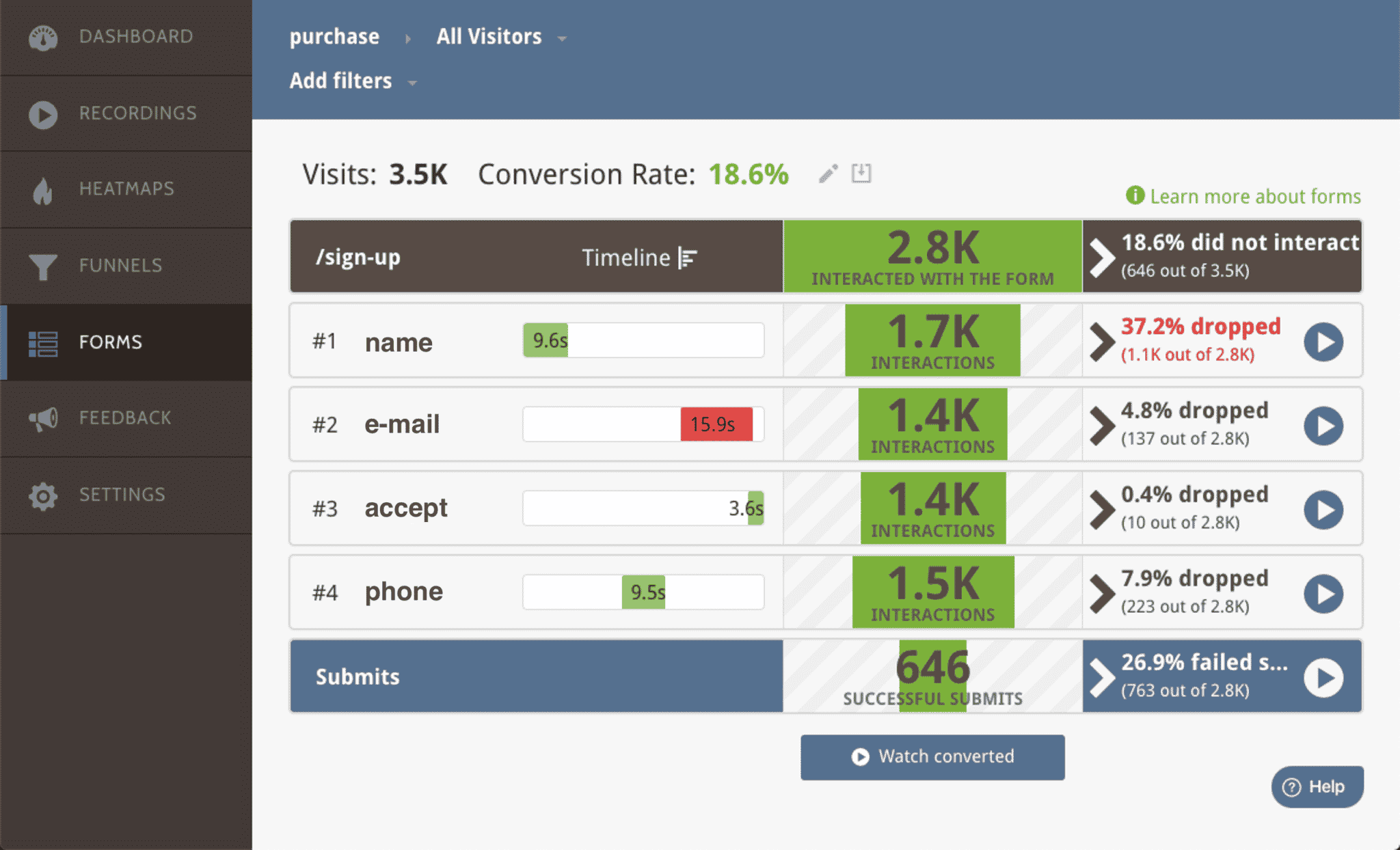
5. Email marketing
One of the most effective forms of reaching out to your customer base is through email marketing. Although you have to be very careful about the content within your emails and who is included in your outreach, the reason email marketing has been around for so long is because it’s a great marketing channel – it works.
In order to reach your audience most effectively, provide useful content within your emails. Make them as personal as you can, offer valuable promotions, and use it as an opportunity to socialize.
Open up about what your business is doing, any events you are attending, new features or products, and be transparent about your company. You want to relate to your customers on a level that gauges their interest and keeps them engaging with your emails.
As always, make sure you are monitoring the analytics of your email marketing efforts, and any ecommerce marketing strategy elements, for that matter. Remember to follow email design best practices to serve up a satisfying message and experience.
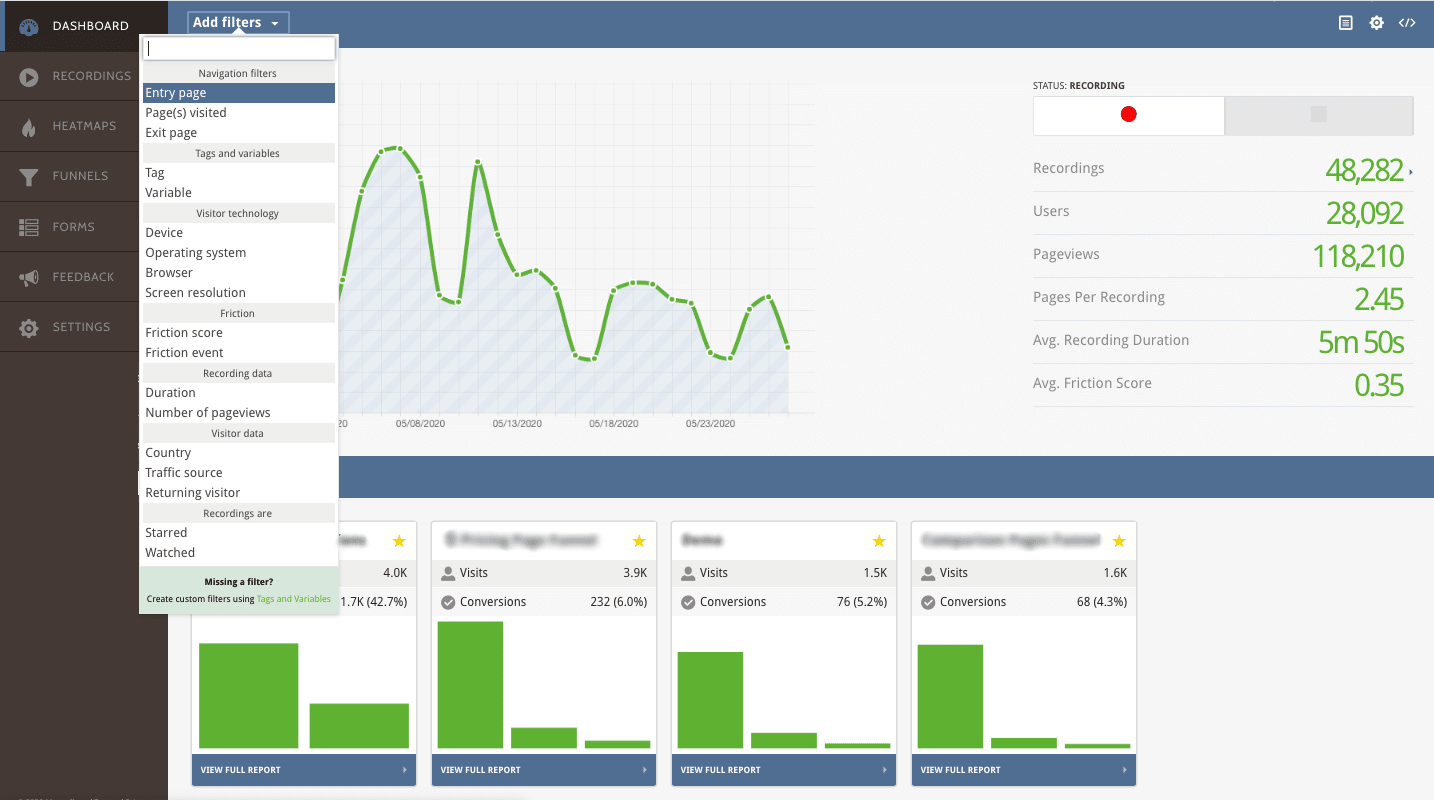
You can also track users who entered your website from your email campaigns with Mouseflow. All you have to do is set a custom URL that users “visit” when entering your site, and their entry page will contain that unique URL. A great way of doing this is to append UTM variables to your URL.
You can use Mouseflow filters or the search feature to find users whose sessions contained your custom URL. From here, you can save and export the list, perform analytics, and watch how they interacted on their site.
You can also filter your heatmaps for this data to analyze how they engage with each page of your site, which elements they find most attractive, and more!
For Level Two of email marketing, consider how triggered emails can be leveraged to recover lost conversions, such as abandoned carts. Email marketing automation is a great way to engage existing customers and make them return to your website.
6. Search engine optimization (SEO) for ecommerce

One of the most important and manual methods of improving an ecommerce website is making sure it’s optimized for search engines. With today’s Search Engine Optimization (SEO) standards, it’s now more important than ever to make sure your website is constantly updated with rich and relevant content, promotes a good user experience (UX), and is optimized to be as error-free as possible.
The content within your website should be rich, reliable, and provide information to the public that is useful and relevant to what they’re looking for. For example, if you have an ecommerce store selling camping supplies, it’s wise to provide detailed product information on each and every product page, and possibly even host sections of your website that offer generous amounts of content that elaborates on the topics of camping, supplies, or related subjects.
Using keywords within your content in a genuine way will also flag your website as a matching result in search engines when users are looking for something specific. Search engine optimization is one of the lowest-cost, highest ROI ecommerce marketing strategies you can deploy. To make sure eCommerce SEO is effective, you need to track SEO metrics that are important for eCommerce.
Want more? Here’s how to leverage your web analytics tool to get better results from SEO.
7. Pay-per-click advertising (PPC for ecommerce)
There are three basic elements to any pay-per-click marketing campaign: the ad, the offer, and the landing page.
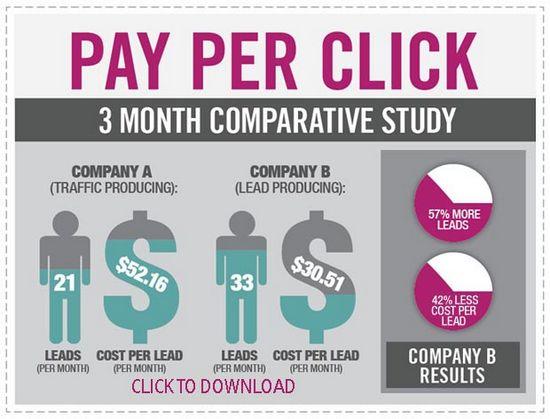
All three must be in good harmony and synchronization if you want to maintain the interest of the lead. The landing page must be a continuation of your ad, delivering what was promised as the reward of clicking on the ad, in order to take the visitor through your conversion funnel.
It must also be customized for keywords to appear somewhere near the top of search engine results. Likely, these keywords will play into the rest of your eCommerce marketing strategies, too.
Keep the landing page free of distractions and unnecessary bells and whistles. Also, keep in mind that your landing page is the most appropriate place to boast your product benefits to the customer.
To measure performance, use your web analytics tool’s filters to identify the UTM-coded audience. Be it Google Ads, Facebook Ads, Pinterest, Reddit, or something else, the general principles described here remain the same.
8. Optimize for mobile
In 2024, 2/3 of purchases were made using a mobile device (according to Statista).
And 77% of traffic to eCommerce websites also came from mobile. Which means, optimizing an eCommerce website for mobile and providing good UX for everyone, no matter the device type, is a must have strategy for every online store.
What does it take to optimize for mobile?
- Make sure your website is responsive and looks good on every screen layout. People who visit your website do not want to be redirected to an app or web version of your website, they want the full-meal-deal.
- Make sure your website loads fast. Mobile internet connection is usually slower and less stable, but users still expect to have a good experience.
- Make sure all crucial website elements are present and working on mobile. We’ve seen “responsive designs” where add-to-cart button was nowhere to be found on any mobile device.
Want to know exactly which parts of your website need tweaking to work better on mobile? That’s actually pretty easy.
Use a behavior analytics tool like Mouseflow and filter the list of session replays by mobile and by high friction. Watch how those “unhappy” and “very unhappy” users navigate your website – and see what makes them struggle. That’s the most visual way of understanding what’s wrong with your website on mobile devices.
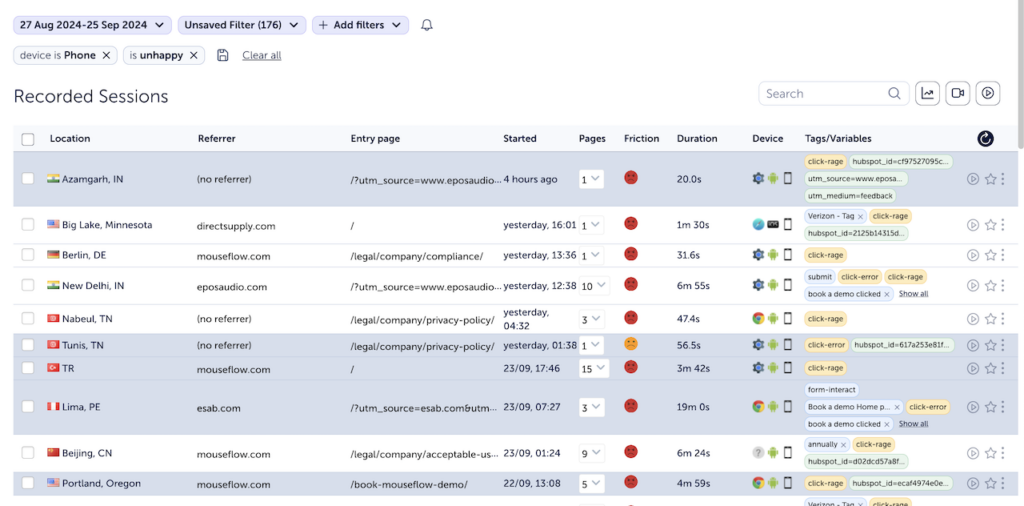
Filtering the list of session replays by mobile and high friction in Mouseflow
You can also use mobile marketing techniques to target mobile users specifically. One of the most popular marketing trends is called geo-targeting, which advertises to mobile users based on their location. This technique enables you to reach out to customers who are within a specific distance of your business, and provide them with an incentive to stop by or make a purchase.
Then, leverage geo heatmaps to audit the effectiveness of your regional campaigns. You can even use these geo heatmaps to strategize which regions to target, either chasing what works or breaking into untapped markets.
9. Use social commerce
As people spend more and more time on social media, it’s only natural that retail companies want to reach them there, ideally selling something directly. And they can! Enter social commerce: the practice of selling products directly through social media platforms.
Social commerce enables users to discover, engage with, and purchase products without ever leaving their favorite apps. They scroll through their feeds, see something that catches their eye – and can buy it without leaving the platform. This blend of social and shopping is becoming one of the most significant eCommerce marketing strategies for brands to adopt in 2024 and beyond. While in 2020 the share of social commerce was less than 10% according to Statista, it grew to 19.7% in 2024 and is expected to grow to 21.7% by 2028.

Pinterest explaining how social commerce works on the platform
The rise of social commerce coincided with the rise of short-form video content on platforms like TikTok and Instagram Reels. The infinite feeds of creator videos are perfect for grabbing attention, showcasing products, and inspiring purchases—all while keeping users entertained.
Key Elements of Social Commerce
- Shoppable posts
Platforms like Instagram, Facebook, and Pinterest now offer shoppable posts, allowing brands to tag products in their content. When users click on these tags, they receive detailed information about the item and can purchase it directly.
This shortens the purchasing journey, making it not only more convenient but also visually engaging. Imagine scrolling through your feed, spotting a pair of shoes you love, and buying them without navigating away from your feed—simple, quick, and highly effective. - In-App shopping and checkout
Instagram and Facebook have also introduced a feature called Shops where users can browse catalogs, learn about products, and purchase in-app. TikTok is also tapping into this trend with its own shopping features.
Benefits of Social Commerce
- Staying within one platform. Social media platforms are designed to keep people engaged for as long as possible without leaving the platform. Social commerce allows customers to discover and purchase products within the same social platform, without leaving it, which is more in line with what the platforms desire and is thus cheaper for eCommerce businesses than driving traffic from social media platforms to their online stores on their own websites.
- Shorter buyer’s journey. Social media has always been a great means of product discovery, helping brands get their products in front of new potential buyers. With the introduction of social commerce, the journey between discovery and purchase became shorter.
- Social proof and trust building: Social commerce allows to incorporate social proof – likes, comments, and reviews from influencers – naturally into the purchasing process.
10. Humanize and personalize
Consumers have become the power player in the ecommerce industry. Which means your business needs to stand out in a unique way. Because of this, it’s more important than ever to customize your user experience (UX) to cater to the needs of your audience. This is just as much a crucial part of your ecommerce marketing strategies as it is a total brand strategy.

Make your outreach efforts personal by taking the time to learn about your customers. People love it when they feel special, and if you make sure to add personal touches like addressing your prospects by name, sharing videos and pictures of your employees, and being transparent about your company processes and procedures, you will reap the benefits of a loyal customer base.
All of this adds to the overall ‘face of the business’. This will hopefully make its way to the hearts of your customers.
11. Retargeting
Customers who have already shown an interest in your website are more likely to make a later purchase.
Retargeting is a technique that tracks customers who have visited your website and displays ads to them while they’re browsing the internet with the intent of getting them back on your website. When these visitors enter your website again, they are far more likely to make a purchase.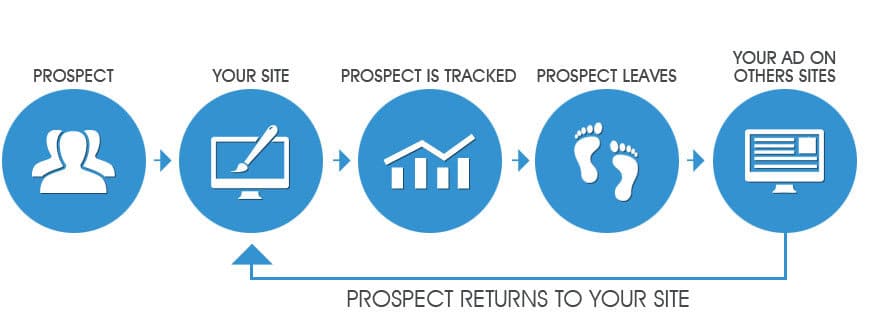
To effectively manage a retargeting campaign, make sure your ads are as specific as possible. Was the customer looking at a specific product? Make sure the ads displayed to them are ads of that specific product and link to the page of the product. Just like with Search Engine Optimization (SEO) and Pay Per Click (PPC) marketing, it’s important to display the information the user is looking for the instant they click on your ad.
If they click on an ad for hiking boots and are redirected to the home page of your camping website, they aren’t going to be thrilled. But, if they are directed to the exact hiking boots they were considering, or even had added to their cart, before leaving your website, they will be much more likely to continue with a purchase.
Although retargeting is getting more difficult due to the demise of third-party tracking cookies, there’s still opportunity to be chased.
Which ecommerce marketing strategies will you deploy?
Staying current with the latest marketing trends and techniques is crucial for any successful eCommerce website. It’s important to deliver relevant, interesting and valuable content and products that truly suite the needs of your target market. If you get stuck with implementation, you can partner with an top eCommerce website development company that can help bring your strategies to life.
Reach out to your customers in a variety of ways and make sure you are working with a team of experts with varying skill sets. If you listen to everyone’s ideas, you may find new ways of improving your current campaigns and outreach methods.
And, as always, make sure you are monitoring your website analytics to examine trends, keep your website optimized, and track your results!
With the right mix of marketing techniques, you can improve your conversion rate and attract sustainable business that will continue growing over time. Remember though, that the process of eCommerce optimization is endless – you run experiments, apply changes that work, and then come up with new hypotheses. Sharpening your skills as an ecommerce website marketing manager will help you level-up and become more attractive in the job market.
Next steps to ecommerce success
Here’s where to head next:
- Check out this live mouse tracking demo to see firsthand how behavior analytics works.
- Clean up your site’s UX, starting with the most revenue-draining elements.
- Lay out a conversion rate optimization roadmap – even if you don’t have tons of traffic to run tests.
- Sign up for Mouseflow’s free, full-feature, 14-day trial (no credit card needed!) and start swimming in a sea of data-opportunity.

